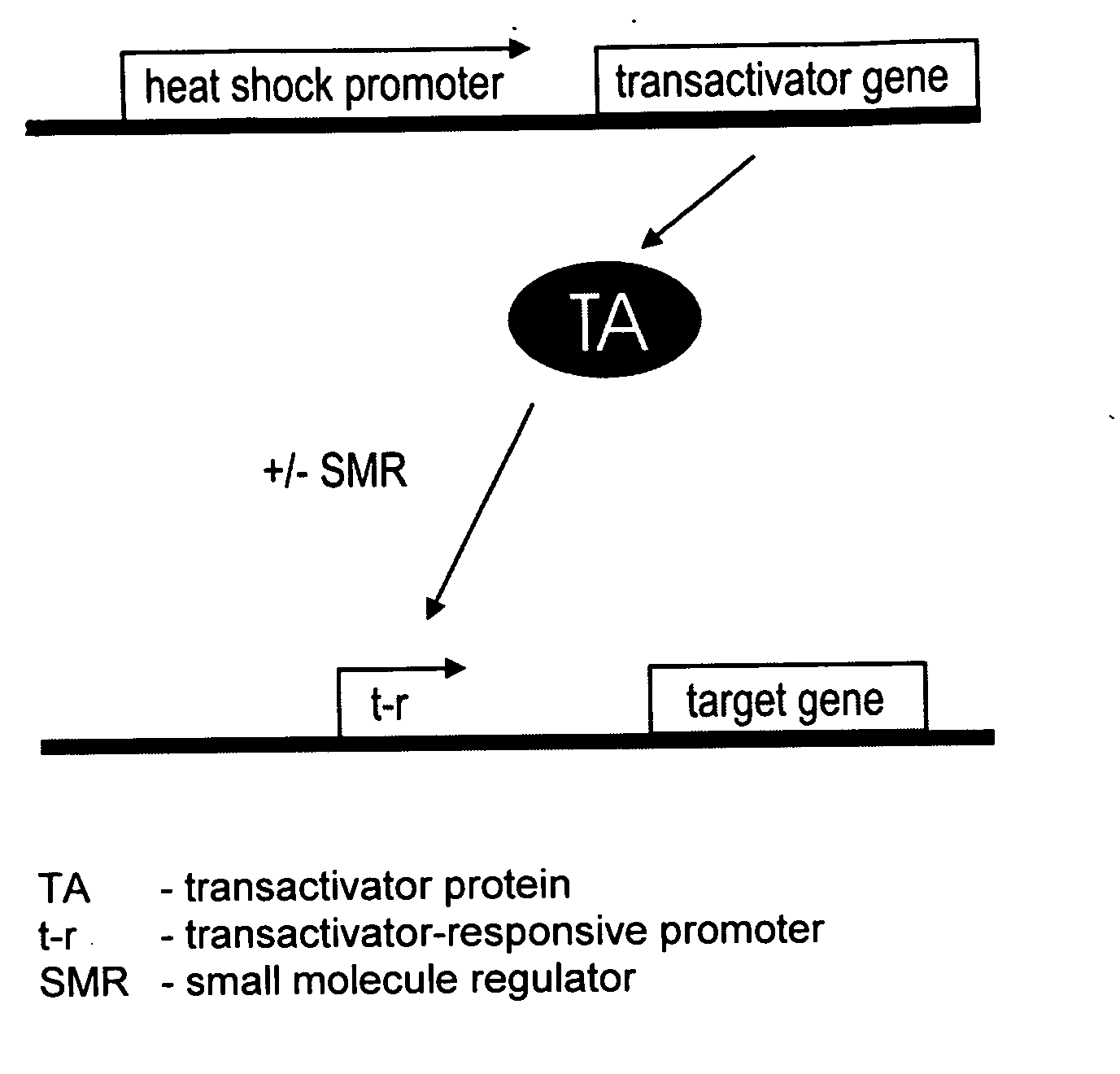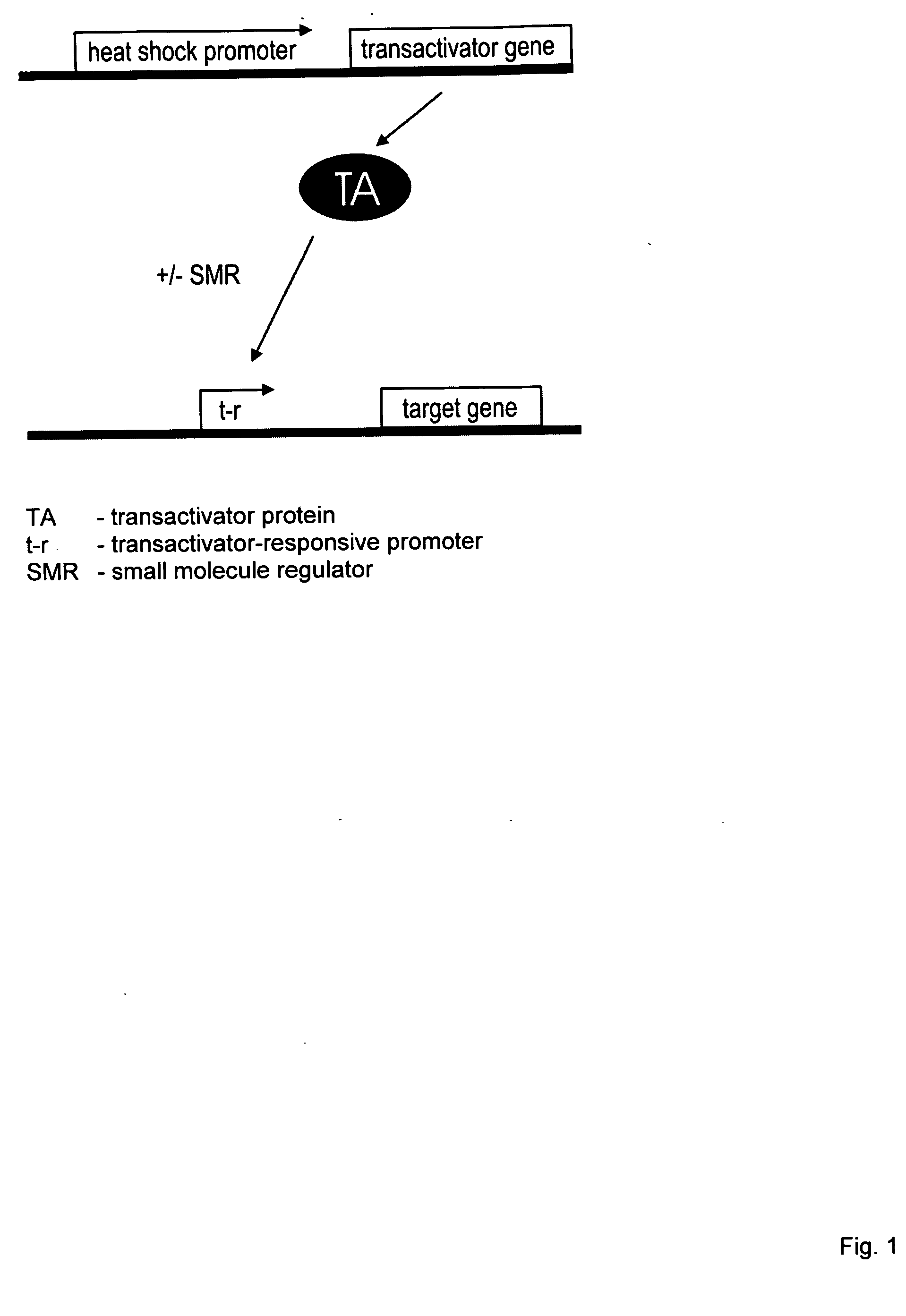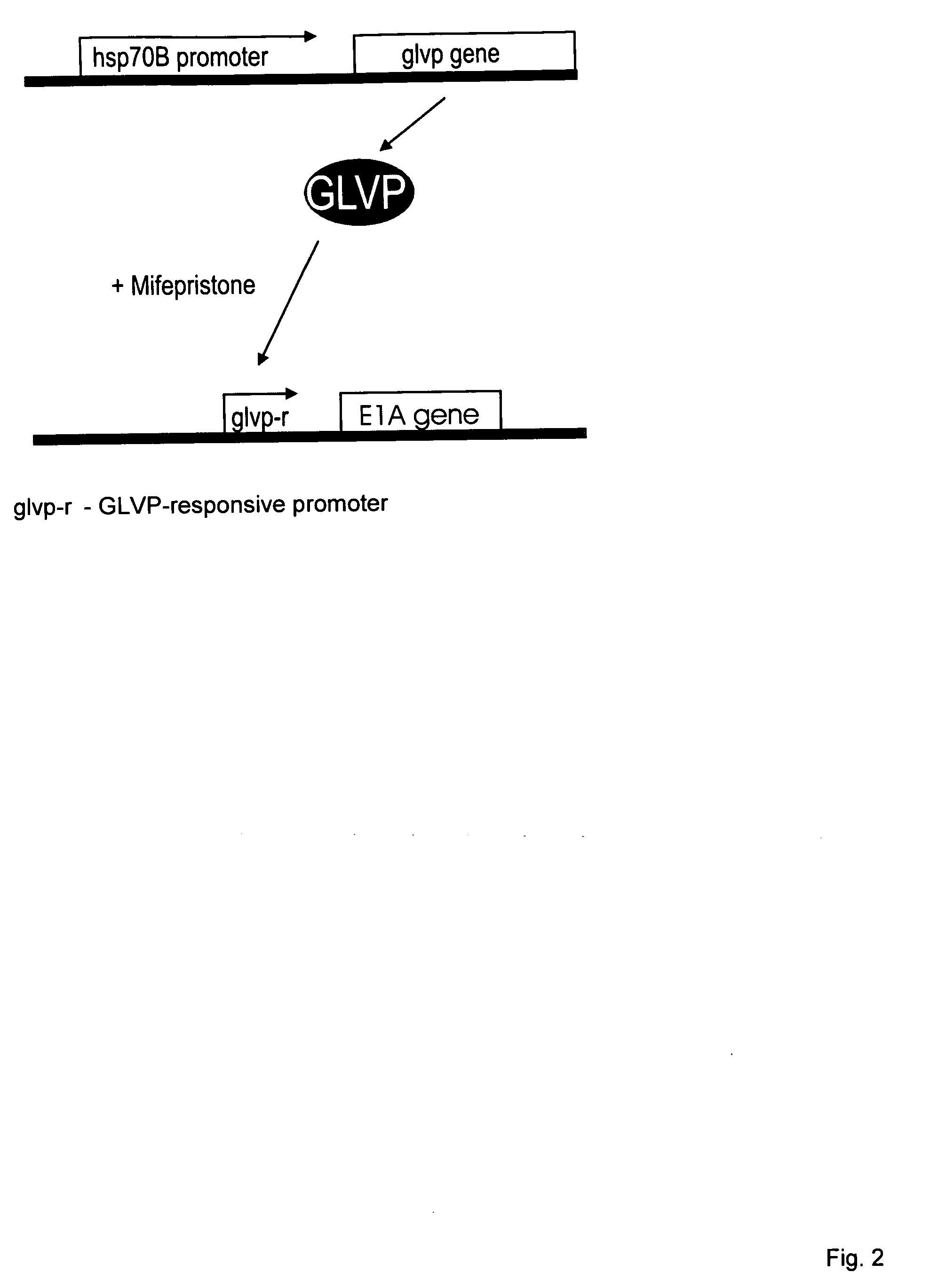[0006]The gene switch that controls the expression of one or more viral genes, whose products are required for efficient viral replication, minimally consists of two components. The first component is a gene for a transactivator that is activated or inhibited by a small-molecule regulator. In preferred embodiments, expression of the transactivator gene is controlled by a functionally linked nucleic acid sequence that acts as a heat shock promoter and is activated by transient heat or a transient proteotoxic stress through the intermediary of endogenous heat shock factor 1 (HSF 1), or by a nucleic acid sequence containing a tandem or hybrid promoter that acts as a heat shock promoter as well as a transactivator-responsive promoter and is activated by transient heat or proteotoxic stress through the intermediary of endogenous HSF1 and active transactivator. The term “transactivator-responsive promoter” as used herein means a promoter that activates transcription of a functionally linked gene subsequent to binding of activated transactivator. Depending on the choice of transactivator, the DNA-binding activity or transcriptional activity of a transactivator may be induced or inhibited upon interaction of the transactivator with its small-molecule regulator or ligand. It is noted that the above single first component may be replaced by a set of two or more components that together perform the function of the single first component. For example, a transactivator gene that is functionally linked to a nucleic acid sequence which acts as a heat- and transactivator-responsive promoter may be replaced by a set of two genes encoding the same transactivator, the first gene being functionally linked to a nucleic acid that acts as a heat shock promoter and the second gene to a nucleic acid that acts as a transactivator-responsive promoter. Further, a transactivator may be a hetero-oligomeric protein. In such a case, the first component of a gene switch would the an assembly of all required subunit genes, at least one of which genes would be functionally linked to a nucleic acid sequence which acts as a heat shock promoter or as a heat-activated and transactivator-responsive promoter. The second component of the gene switch is a nucleic acid sequence that acts as a promoter responsive to the transactivator, which promoter is functionally linked to the viral or passenger gene to be regulated. The second component may also be a set of similar nucleic acid sequences that act as transactivator-responsive promoters and are functionally linked to viral and / or passenger genes to be regulated. In alternative embodiments, the first gene switch component is a transactivator gene, or set of subunit genes for a hetero-oligomeric transactivator as the case may be, that is expressed continuously (constitutively) in a host cell. The second component can be a modified heat shock promoter (including an appropriate RNA leader region) or a set of such promoters that are activated by transient heat or other proteotoxic stress and repressed by the transactivator. Binding of a small-molecule regulator to the transactivator can, respectively, inhibit or enable its repressing function. Hence, the resulting gene switch is active in cells exposed to heat or proteotoxic stress in the presence or absence, respectively, of the small-molecule regulator. In yet other alternative embodiments, the first component is a transactivator gene, or set of subunit genes for a hetero-oligomeric transactivator as the case may be, that is expressed continuously (constitutively) in a host cell. The second component can be a modified heat shock promoter or a set of such promoters that require co-activation by transactivator and endogenous HSF1. Transactivator may be activated by a bound small-molecule regulator or, alternatively, upon removal of a bound small-molecule regulator.
[0007]The invention also relates to a conditionally replicating pair of modified viruses consisting of (a) a first virus that is defective in one or more genes required for efficient replication and whose genome includes a gene for a small-molecule-regulated transactivator, the gene for the small-molecule-regulated transactivator being functionally linked to a nucleic acid sequence that acts as a heat shock promoter, and (b) a second virus comprising all genes required for efficient replication of which genes at least one gene is under the control of a promoter that is responsive to the small molecule-regulated transactivator of the first virus and is not complemented by a functional gene of the first virus, wherein expression of all genes of the second virus required for its replication will complement the defects of the first virus and result in replication of the first virus. This embodiment of the invention relates to a pair of modified viruses whose combined genomes contain all genetic information required for conditional replication of the virus pair. The first virus is a replication-defective virus lacking one or several genes required for efficient replication of the virus, whereas the second virus contains all genes necessary for its efficient replication, but one or more of the latter genes have been placed under the control of a gene switch that is activated by a transient stress such as heat and a small-molecule regulator. The stress- and small-molecule regulator-controlled gene or genes of the second virus are genes with functions in replication that cannot be provided by functional genes present in the first virus.
[0008]The gene switch that confers stress (e.g., heat) and small-molecule regulation upon one or more genes of the second virus comprises minimally two components that are distributed between the two viruses. The first virus contains the transactivator component that consists of a gene for a nonviral small-molecule-regulated transactivator, or of two or more genes if the transactivator is a heterooligmeric factor. The gene or, in the case of heteromeric transactivators, at least one of the genes for the transactivator is functionally linked to a nucleic acid sequence that acts as a heat shock promoter. In a variant embodiment, the transactivator gene, or at least one of the genes encoding a subunit of a multimeric transactivator, is functionally linked to a nucleic acid sequence that acts both as a heat shock promoter and a transactivator-responsive promoter. The transactivator component may also comprise two identical transactivator genes, of which one is functionally linked to a nucleic acid sequence that acts as a heat shock promoter and the other is linked to a nucleic acid sequence that acts as a transactivator-responsive promoter. The second virus contains the second gene switch component that is a nucleic acid sequence acting as a transactivator-responsive promoter. This promoter sequence is joined functionally to a gene required for efficient replication of the second virus. Multiple genes of the second virus may be joined to such a promoter sequence, subjecting them to control by the transactivator. Transactivator may be activated by a bound small molecule regulator or, alternatively, upon removal of a bound small molecule regulator.
[0009]The invention also concerns a conditionally replicating pair of modified viruses consisting of (a) a first virus that is defective in one or more genes required for efficient replication and whose genome includes a gene for a small molecule-regulated transactivator, the gene for the small molecule-regulated transactivator being functionally linked to a nucleic acid sequence that acts as a continuously active promoter, and (b) a second virus comprising all genes required for efficient replication of which genes at least one gene is under the control of a promoter that is activated upon simultaneous binding of a heat shock factor and activated transactivator and is not complemented by a functional gene of the first virus, wherein expression of all genes of the second virus required for its replication will complement the defects of the first virus and result in replication of the first virus. The first component of the gene switch in this particular embodiment consists of a continuously expressed gene for a small-molecule-regulated transactivator that is present in the genome of the first virus and is active either in the absence or in the presence of the small-molecule regulator. The second component consists of a promoter that is used to regulate one or more genes in the second virus required for efficient replication of the virus. This promoter is only active in a cell infected with the conditionally replicating pair of modified viruses subsequent to heat exposure of the cell in the presence (in the case of a small-molecule-activated transactivator) or absence (in the case of a transactivator that is inhibited by its small-molecule ligand) of small-molecule regulator. A promoter of this type may be assembled by supplementation of a basal promoter with binding sequences for heat shock transcription factor and transactivator. Alternately, one or more binding sequences for the transactivator may be introduced in an existing heat shock promoter such as the human hsp70B promoter.
[0010]The modified viruses of the conditionally replicating virus pair are typically derived from viruses of the same family, preferably from viruses of the same genus, and most preferably from viruses of the same species. These preferences are derivative of the requirement that products of one or more genes of the second virus of a pair need to be capable of complementing genetic defects of the first virus of the pair. Occasionally, this requirement is fulfilled even though the two viruses of a pair are derived from viruses of different families. An example pair of this kind could consist of a first virus derivatized from an adeno-associated virus and a second virus from an adenovirus. A further condition that needs to be fulfilled by a conditionally replicating virus pair of the invention is that the functions of the gene or genes in the second virus that are under transactivator control cannot be provided by functional genes in the first virus.
[0011]A conditionally replicating virus pair of the invention may further include a passenger gene that is inserted into the genome of the first virus of a pair. The passenger gene may be placed under the control of the same small-molecule-regulated transactivator that controls viral replication. Preferably, the modified viruses of a pair are modified members of the Adenoviridae, Herpesviridae, and Retroviridae families, with both viruses of a pair belonging to the same family. More preferably, each virus of a pair is derived from a member of the Adenoviridae family. Most preferably, each virus of a pair is an adenovirus. If the second virus of a conditionally replicating virus pair of the invention is a modified adenovirus, the genes that can be controlled by the gene switch include the E1A, E1B and E4 genes of the second virus.
 Login to View More
Login to View More 


